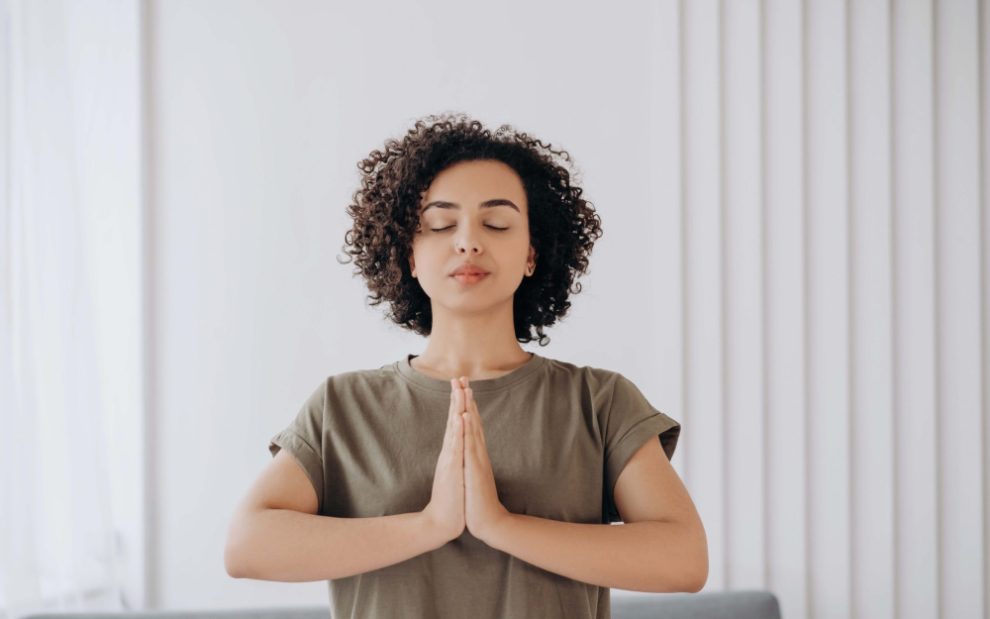This past semester I had the opportunity to teach a yoga class to my honors Foundations in Theology students in the chapel on my university’s campus. As I rolled out my yoga mat in front of the altar, I noticed how two powerful symbols of embodied spirituality—the eucharistic welcome table and the practice of yoga—were side by side. It felt so beautiful to me, so very right. During class we collectively swept our arms to the sky in sun salutations as we gazed up at the setting sun pouring through the stained glass windows. As I rolled up my mat at the end of class, I wondered if the practice of yoga—which in Southeast Asian traditions invites practitioners to find balance in the body, breath, and mind to achieve unity with God—is not so different than reflections on our connection to the body of Christ in our own bodies.
As a theology and ethics professor at a Jesuit university and a yoga and mindfulness teacher, I believe that the practice of yoga and the Catholic tradition of contemplative prayer go hand in hand. When I step on my mat and begin to quiet the chatter of my mind, I am able to breathe and move in a way that draws me away from fear and anxiety and brings me closer to divine love. My yoga practice has not only helped me grow closer to God but also led me to recognize the many similarities between the philosophical teachings of yoga and the contemplative practices found within the Christian tradition.
The word yoga means “to yoke” or “to join” in Sanskrit and draws its lineage from Hinduism, Buddhism, and Jainism. Although present in a variety of Vedas, the sacred religious texts within Hinduism, no one compiled the philosophy of yoga into one volume until the Indian philosopher Patanjali wrote the Yoga Sutras in the second century, explains Mara Carrico in her article “A Beginner’s Guide to the History of Yoga.” What people in the West may recognize as the series of movement postures in yoga, or asanas, were traditionally intended to prepare the body for meditation. Through describing the eight “limbs” of yoga, the Yoga Sutras provide spiritual teachings on how to train the body and mind in order to draw a person into union with the divine, or samadhi, writes Tracee Stanley in her book Radiant Rest: Yoga Nidra for Deep Relaxation and Awakened Clarity (Shambhala Publications).
Many lineages of contemplative prayer within the Christian tradition, including St. Ignatius of Loyola’s Spiritual Exercises, also seek to draw practitioners closer to the divine by providing guidance on how to observe God’s presence in daily life, in and through the body. In the Spiritual Exercises, St. Ignatius teaches that by recognizing that God is in all things, working through all creation, we can become “contemplatives in action,” moving about our days with the ultimate goal of “[living] with God forever.”
According to St. Ignatius, one way to draw closer to God is through the practice of “indifference,” a form of detachment from any created thing that hinders a person’s connection with God. This detachment from earthly goals or achievements leads to spiritual freedom, according to St. Ignatius’ First Principle and Foundation. This concept of indifference has strong similarities to the teachings of the eight limbs of yoga, particularly the yamas, the principles of earthly non-attachment that help a person draw closer to the divine.
In 2016 Bobby and Alan Haras cofounded what is now known as Ignatian Spirituality & Yoga, based on their observation that people were craving the integration of these two traditions. They began leading weekend retreats cosponsored by the Midwest Province of the Society of Jesus. According to their website:
The practices of Ignatian spirituality and yoga invite spiritual seekers to . . . discover deeper connection with self, others, nature and God; . . . experience transformation that leads to ever greater interior freedom; . . . [and] commit to conscious action that embodies a faith that does justice.
Yoga teachers and activists I have had the privilege of knowing through the Socially Engaged Yoga Network and Inner Sense Healing Arts Collective in Chicago share in this belief that yoga is a transformational, spiritual practice that propels students to step off of their mats and work for justice in the communities around them.
I began practicing yoga as a stressed-out graduate student seeking a space to move my body intentionally, control my breath and mind, and listen to the voice of God within myself. When I stumbled upon the studio in my neighborhood, I knew I had found a unique tool for my spiritual, mental, and bodily healing and growth as a Catholic woman.
Catholic saints and mystics have embraced embodied and incarnate spiritual practices for centuries, rooted in the belief that our bodies are temples of the Holy Spirit and that we can use our bodies to glorify the Creator. Before each theology class I guide my students through an awareness meditation to help them notice the subtle movements within their bodies as a way to connect to the divine that lives within each of them. In many ways, yoga has made me a better Catholic and vice versa. After all, life—and spirituality—is most interesting at the intersection.
This article also appears in the June 2022 issue of U.S. Catholic (Vol. 87, No. 6, pages 45-46). Click here to subscribe to the magazine.
Image: Pexels/Mikhail Nilov












Add comment